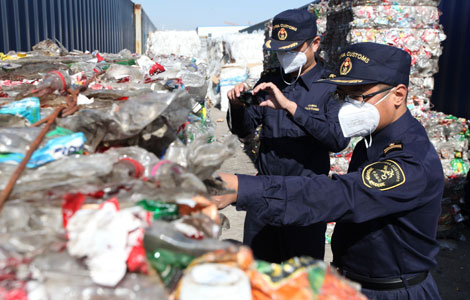Nation set to bolster the import of rice
Updated: 2013-10-18 08:08
By Zhong Nan (China Daily USA)
|
||||||||
The government is expected to further lower the bar on rice imports, in a bid to boost the country's food supply, industry experts said.
The China National Grain and Oils Information Center forecast that the country's rice output will drop 0.7 percent year-on-year to 202.8 million metric tons in 2013, indicating the rice production is falling after stable output growth for a decade.
As the world's biggest rice consumer, China imported between 500,000 and 600,000 metric tons of rice per year until 2012, when local prices lost their competitiveness against rice imported from neighboring countries.
Ding Shengjun, a senior researcher at the Academy of the State Administration of Grain, said that adverse weather and floods in major rice-growing regions, such as Hunan, Jiangxi and Zhejiang, have curbed the country's rice output and deepened reliance on imports.
During a visit by Premier Li Keqiang to Bangkok this month, China agreed to raise the amount of rice to be imported from Thailand over the next five years to 1 million metric tons per year.
"After decades of efforts to pursue higher outputs, China's rice sector is seeing a decline in competitiveness," Ding said. "The government has realized that the country's rice farmland needs a break after years of heavy use of fertilizers, pesticides and herbicides."
The country accounts for 26 percent of the world's rice production.
Like other Asian countries, China has implemented policies to encourage rice cultivation by guaranteeing minimum purchase prices. But after almost a decade of increases, rice prices are now well over those seen in international markets.
The China National Grain and Oils Information Center said the per hectare rice production level has also declined, with the rice yield per hectare falling 1.7 percent to 6.7 tons this year. However, the corn and wheat yields per hectare rose 2.6 and 1.6 percent, respectively.
"The fast pace of industrialization and urbanization has transformed a number of rice farmland areas into manufacturing facilities and residential housing projects. This transformation to a certain extent has gradually shifted the country's rice production center from the south to the north," said Wen Tiejun, dean of the school of agricultural economics and rural development at the Beijing-based Renmin University of China.
Wen said that outdated grain logistics services have also hampered the efficiency of the rice production system.
The northeast region is far away from the major rice consumption provinces, but the grain logistics system is not ready for that challenge yet.
For instance, rice transportation costs from Heilongjiang province to major consumer markets in Zhejiang and Jiangsu now account for about 30 percent of retail rice prices, according to a study by the Harbin-based Northeast Agricultural University. That puts extra pressure on logistics companies to satisfy rice demand during peak seasons, and offers opportunities for companies in South China to buy rice from neighboring countries such as Cambodia, Myanmar and Vietnam.
Ding Lixin, a researcher at the Chinese Academy of Agricultural Sciences in Beijing, said that the increasing rice imports stem from the notable price differences between foreign and domestic rice.
He said that rice imports will be kept at a high level if domestic rice prices continue to rise before the Lunar New Year, which will be in late January 2014.
However, domestic prices might be capped by the increase in imports.
"Under such circumstances, sufficient rice supply from the global market and the low import prices from countries such as Thailand, Indonesia and Vietnam have all become important elements subduing the rising pace of Chinese rice prices," he added.
zhongnan@chinadaily.com.cn
|
Traders show great interest in rice from Cambodia at the China-ASEAN Expo in Nanning, Guangxi Zhuang autonomous region. China's rice output is expected to drop 0.7 percent year-on-year to 202.8 million metric tons this year. Huo Yan / China Daily |

(China Daily USA 10/18/2013 page17)
Most Viewed
Editor's Picks

|

|

|

|

|

|
Today's Top News
China warns of emerging markets' slowing demand
Roche boosted by strong drug sales in US, China
IBM's China-driven slump sparks executive shakeup
US not budging on its arms restrictions on China
Can cranberries catch on in China?
Asia-Pacific pays executives world's highest salaries
US debt deal a temporary fix
China is No 1 oil importer
US Weekly

|

|














